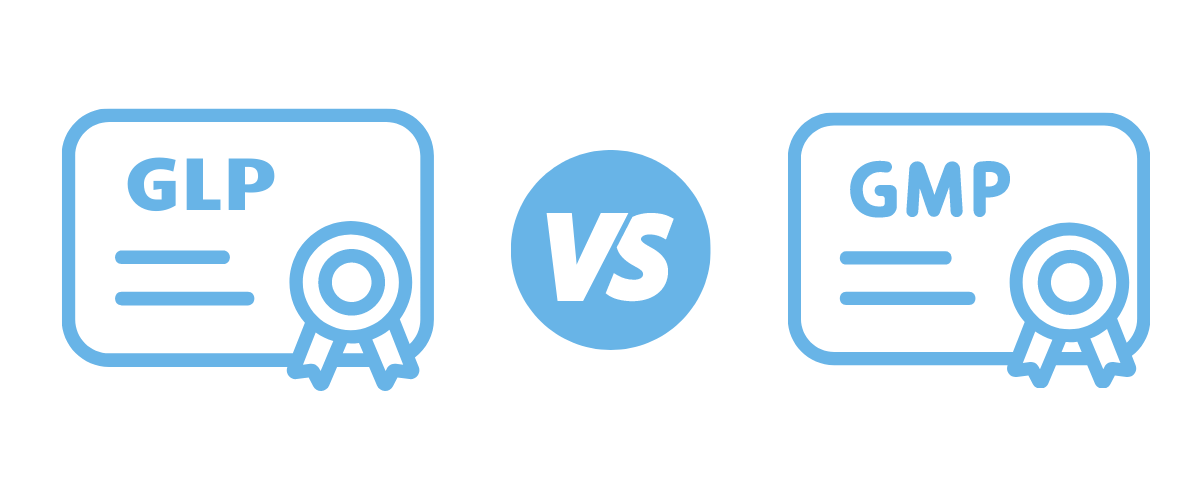
When it comes to pharmaceutical laboratory testing, there is an abundance of regulations and just as many accompanying acronyms. In this article, we will cover the difference between good laboratory practices (GLP) and good manufacturing practices (GMP).
Though they sound similar and may be interchangeable in some cases, they have meaningful nuances that you should take note of. Mixing them up could lead to major compliance issues and even force you to repeat the tests you’ve performed under different conditions.
Before we get to their differences, let’s first go over how GLP and GMP are similar. Both GLP and GMP are overseen by the Food and Drug Administration (FDA). They are also both sets of standards meant to protect the public and assist those regulating the industry.
That’s about where the similarities end; their differences are numerous and quite noteworthy. Here is a bulleted list outlining said differences:
Study Director
- GLP
- There must be a single point of contact for the study, with an overall responsibility and control of the study and its components. This point of contact is appointed by testing facility management.
- GMP
- There is no study director assigned or appointed and no single point of contact required.
Quality Assurance Unit and Quality Control Unit
- GLP
- Features the quality assurance unit and inspects critical phases of each study and periodically inspects the facility.
- Is required to inform testing facility management of the integrity of the studies and compliance or non-compliance with the GLPs.
- Is entirely separate from the personnel engaged in the study.
- Does not engage in quality system or control.
- GMP
- Employs the quality control unit which has the responsibility and authority to approve or reject all procedures and aspects of testing/manufacturing.
- Functions as the overall quality system.
Testing Facility Management
- GLP
- Is responsible for designating a study director with appropriate education and training for each study.
- Ensures there is a quality assurance unit separate from the personnel engaged in the study.
- Makes sure the facility, personnel, equipment, etc. is available and complies with the GLPs.
- GMP
- Supervisors should have proper training.
- Responsibilities should be stated clearly in written procedures and followed to the letter.
- Serves as an oversight function.
Type of Testing Conducted
- GLP
- Open-ended determination of product performance, often for submission to the EPA or FDA for pre-market approval.
- GMP
- Determination of whether or not the product or sample has met manufacturing specifications and standards.
Facility
- GLP
- Design and construction must be suitable to the type of testing being conducted, with well-defined separation of areas to minimize mix-ups and contamination.
- Lighting, plumbing, sewage, and washing facility regulations are not explicitly mentioned under GLPs.
- GMP
- Design construction must be suitable to the type of testing being conducted, with well-defined separation of areas in order to minimize mix-ups and contamination.
- Lighting, plumbing, sewage, and washing facility requirements are specified under GMPs.
Equipment
- GLP
- Equipment must be appropriate, maintained, and the state of equipment at the time should be documented to provide the ability to reconstruct the study.
- Data-generating equipment is calibrated.
- GMP
- Equipment must be qualified for use in manufacturing processes.
- Data generating equipment for product testing purposes is calibrated.
- The accuracy, sensitivity, specificity, and reproducibility of test methods shall be established and documented.
Standard Operating Procedure (SOP) or Written Procedure
- GLP
- To be drafted by any qualified personnel and approved by testing facility management.
- GMP
- Drafted by any qualified personnel and approved by the quality control unit.
Standard Operating Procedure (SOP) or Written Procedure
- GLP
- Each study requires a specific study protocol indicating study objectives and methods for conduct and is duly approved by both the study sponsor and the study director prior to initiation.
- Protocol overrides SOPs.
- GMP
- Study-specific protocols are not required.
- Standard written procedures are followed.
Master Schedule
- GLP
- An index of all studies is maintained by the quality assurance unit.
- GMP
- Master schedule isn’t addressed.
Records and Reports
- GLP
- Signature or initials of personnel conducting all procedures, preparations, calibrations, etc. are required along with dates completed and must be present on all records.
- Records are maintained in secure archives for at least 5 years following the date of registration if they are used to support a marketing permit, or 2 years following the study’s completion or termination.
- Archivist is responsible for archives and ensures security of documentation.
- GMP
- Signature of both the personnel conducting the procedures and the personnel verifying the steps of the procedures must be on all records.
- This is known as dual control of procedures and records.
- Records are maintained (not specified in archives) for at least 1 year following the expiration date of the product.
- Signature of both the personnel conducting the procedures and the personnel verifying the steps of the procedures must be on all records.
CAPA System
- GLP
- Not required
- GMP
- Required
To break it down simply, GLPs are based on study. Their purpose is to give the FDA the data it needs to scrutinize and audit the scientific validity of research studies.
GMPs, on the other hand, are concerned with process. They are intended to demonstrate to the FDA whether or not batches of regulated products are manufactured according to pre-defined criteria.
Lot release or lot conformance testing for products on the market are almost always required to be done under GMP, while the testing of safety and efficacy of products should be done under GLP. Knowing the difference between GLP and GMP labs can ensure that all of your hard work isn’t an exercise in futility.
When it comes to building and furnishing your lab, there is a seemingly infinite string of questions that springs to mind. How do I design it? What kind of furnishings will I need? How can I make sure that its specs are compliant with the necessary regulatory agencies? And last but not least, who do I talk with to begin the process of creating my lab?
To answer those questions and many more, OnePointe Solutions is here to help. We can help you from the smallest of requests like countertop replacement to more complex needs, like full scale laboratory design. Whatever your laboratory or commercial needs may be , we can find a solution for you.
Need help planning your lab?
Call us at (866) 222-7494 to speak to a lab planner today. And for more topics like this, visit our blog!


